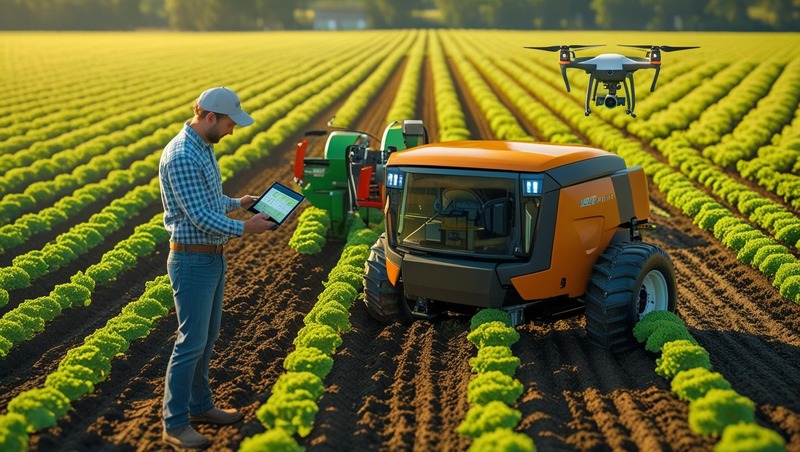The global agriculture sector is undergoing a transformative shift, driven by the imperative to feed a growing global population sustainably. Precision agriculture, with its data-driven and site-specific approach, is at the forefront of this revolution. The precision farming market worldwide will expand from USD 11.38 billion in 2025 to USD 21.45 billion by 2032 at a CAGR of 9.5%. This expansion is fueled by a convergence of technological advancements, increasing demand for food, and a growing emphasis on sustainable farming practices.
Download PDF Brochure @ https://www.marketsandmarkets.com/pdfdownloadNew.asp?id=1243

Key Trends Shaping the Market
Several critical trends are propelling the precision agriculture market forward. The increasing integration of Artificial Intelligence (AI) and Machine Learning (ML) is paramount, enabling sophisticated data analysis from various sources like satellites, drones, and IoT sensors. AI algorithms are now capable of predictive analytics for crop yields, early disease and pest detection, and automated irrigation, significantly optimizing resource use and reducing waste. Furthermore, the widespread adoption of drones and satellites for 24/7 crop health monitoring is becoming a necessity rather than a luxury. Multispectral imaging drones provide rapid assessments of chlorophyll levels, while satellite constellations offer daily field updates, allowing for proactive interventions. The Internet of Things (IoT) is also a foundational trend, connecting a myriad of sensors and devices across farms to collect real-time data on soil moisture, nutrient levels, environmental conditions, and crop growth. This comprehensive data ecosystem facilitates immediate decision-making and automated farm management.
Innovations Driving Growth
The landscape of precision agriculture is continually being reshaped by groundbreaking innovations. Autonomous and electric agricultural machinery, including self-driving tractors and robotic harvesters, are revolutionizing farm operations by enhancing productivity, reducing labor costs, and minimizing human error. These machines, often equipped with AI, GPS, and advanced sensors, can perform tasks like planting, weeding, and harvesting with unprecedented accuracy. Variable Rate Technology (VRT) is another significant innovation, allowing for precise application of inputs such as seeds, fertilizers, and pesticides based on the specific needs of different field zones. This targeted approach optimizes resource utilization and improves crop performance. Beyond the field, biotechnology is enabling precision breeding for crop resilience, leading to higher yield potential and enhanced tolerance to environmental stresses, pests, and diseases. The emergence of nanotechnology in agriculture, with nanosensors monitoring real-time nutrient levels and detecting pathogens, further exemplifies the innovative trajectory of this market.
Market Projections and Regional Outlook
The future of precision agriculture looks exceedingly promising, with strong growth projected across various regions. North America currently holds a significant market share, driven by advanced technological adoption and supportive government initiatives. However, the Asia-Pacific region is anticipated to exhibit the highest growth rate in the coming years, primarily due to the increasing modernization of agriculture in countries like China and India, coupled with a surging demand for food. The market will continue to be segmented by offerings, with hardware (sensors, drones, automation controllers) currently dominating, though the software and services segments are expected to witness higher CAGRs as data analytics and cloud-based solutions become more prevalent. As the agricultural industry strives for greater efficiency, sustainability, and food security, precision agriculture will undoubtedly play a pivotal role in shaping the future of global food production.
Frequently Asked Questions (FAQs) on the Precision Farming Market
- What is precision farming?
Precision farming, also known as precision agriculture, is a farming management concept that uses technologies like GPS, sensors, AI, and data analytics to monitor and optimize agricultural practices. It aims to improve crop yield, reduce input waste, and enhance overall farm productivity by making data-driven decisions. - Why is precision farming important?
Precision farming is important because it increases agricultural efficiency, reduces costs, minimizes environmental impact, and enables sustainable farming. By using real-time data and advanced technologies, farmers can apply resources such as water, fertilizers, and pesticides more accurately, leading to higher yields and better resource management. - How is artificial intelligence used in precision farming?
Artificial Intelligence (AI) in precision farming is used for predictive analytics, crop health monitoring, pest and disease detection, and autonomous machinery operation. AI algorithms process large datasets from drones, sensors, and satellites to provide actionable insights, helping farmers make smarter and faster decisions. - What are the key technologies driving the precision farming market?
The key technologies include GPS and GIS systems, remote sensing, drones, variable rate technology (VRT), Internet of Things (IoT), artificial intelligence (AI), machine learning, robotics, and farm management software. These tools collectively enhance field mapping, resource allocation, and decision-making. - What are the main benefits of precision agriculture?
Precision agriculture offers several benefits including increased crop yield, reduced input costs, enhanced resource efficiency, better pest and disease management, and sustainable farming practices. It enables farmers to make informed, data-driven decisions tailored to specific field conditions. - Which regions are leading in precision farming adoption?
North America, particularly the United States, leads the global precision farming market due to high technology adoption, strong government support, and established infrastructure. Europe and Asia-Pacific regions are also rapidly growing, driven by food security concerns and digital agriculture initiatives.
